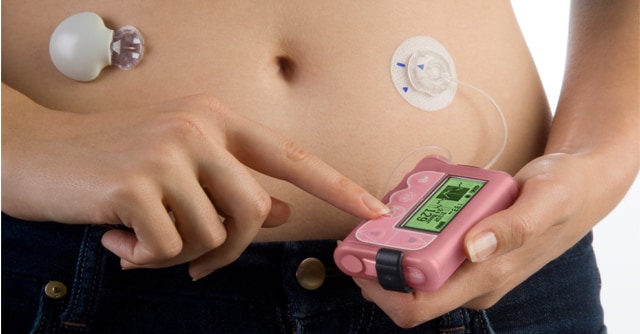6 battery tips for keeping your insulin pump powered up

I've always believed that as a person with diabetes it's important to take what I learn and share this information with others. I have many times benefited by being on the receiving end and learning from my friends with diabetes. I like to use my blog posts as a way to educate and share interesting tips, but to also share my personal experiences (even if it means sharing my mistakes, like I'm about to...)
Last night I got a "Low Battery alert" on my insulin pump and I knew this meant my battery had less than 10% of power, so I should change it before bedtime. I grabbed a battery and a quarter from my drawer, changed it out, and quickly did a few more things in my nightly routine, then crawled into bed.
As I began to drift off to sleep I realized I forgot to check my blood glucose. So, I pushed the button to turn the backlight on my pump to shine over my glucose meter screen so I could see what I was doing in the dark. "Hmmm...that's weird; I wonder why my backlight isn't turning on." I turned on my lamp to realize that I put a completely dead battery in my pump before I went to sleep.
Based on this experience and many others in my almost 10 years of changing pump batteries, here are some tips:
- When you put a battery in your pump make sure to double check that it's working.
- Use a new AAA alkaline battery, not carbon zinc or lithium. You can use any brand, but we recommend Energizer® for the best performance.
- Use a coin such as a nickel or a quarter to open the battery cap when you change it out instead of sharp objects, like a knife.
- The average life span of a battery in your pump is one week. Know that using settings like vibrate mode, the back light, or the sensor will use more battery which can make this time frame vary.
- Keep a spare battery handy, like in your meter case or a drawer at work, but avoid storing it in extreme temperatures. Especially as the weather begins to get cooler this fall, make sure not to place it somewhere where it can get too cold.
- If you get battery alerts and alarms, most can be fixed easily. You can look up the specific alert on our website and follow the steps listed here.
My blood glucose was a lovely 118 this morning, which felt good since I was able to fix the battery ordeal before it impacted my body and my glucose meter screen.



Blog comments
Hi Raymond. I’m not sure what kind of batteries you’re currently using for your insulin pump, but we recommend alkaline Energizer batteries (not lithium or rechargeable). You can learn more about batteries here: http://www.medtronicdiabetes.com/customer-support/device-settings-and-f….
I'm currently using energizer batteries. To save some money I'm looking at the Costco brand batteries. Has anyone used these and what has your experience been with them. Currently I'm at 3 weeks on my first battery, or close to it.
Kevin, although any AAA battery will work for your insulin pump, we recommend alkaline Energizer batteries, not lithium or rechargeable. In our testing, we’ve found lithium batteries drain rapidly once your pump alerts “Low Battery”, which may not leave you enough warning to charge your batteries in time, so the pump could shut off due to the loss of power. This is why we recommended alkaline batteries, and specifically Energizer for best performance.
Currently use 523 but will soon be out of warranty. Has anyone used the new pump with cam and if so how do you like it.?
Many thanks for sharing an informative post! I have founded best information on this blog. I am looking to read more post from you.
Has anyone reported issues with the Duracell Quantum batteries. I have had two instances where the screen went completely blank with no alarm. In addition, I have received a failed battery test after I remove and reinsert the battery. Most recently in the middle of a bolus. I prefer energizer batteries per minimed recommendation but these were handy.
I pulled the battery out of my pump and it was corroded, what should I do?
Colleen, I've asked for my team to reach out to you but in the meantime, please call our 24 HelpLine at 800-646-4633, option 1.
Recently, I have put in an Energizer Lithium battery and 2 days later, I got the low battery alarm. I thought his was very strange as my batteries previously have last quite a long time (a month or better). I replaced it with another Lithium battery and again 2 days later, low battery alarm. This time I replaced it with a regular alkaline Energizer battery like the ones I have used for 10 years. Is using a Lithium battery causing this disruption or is something wrong with my pump now?
Jennifer, in our testing we have found that although lithium batteries seem to work in an insulin pump, once it has a “Low Battery” alert the battery drains rapidly. This could mean that in some cases you aren’t given enough warning in time to change your battery so the pump could shut off due to the loss of power. This is why we recommended alkaline batteries, and specifically Energizer for best performance.
Thank you
What is the warranty on mini med I can not get battery cover off and it's cracking pump trying
My husband has had diabetes for almost 37 years but he is new to using the pump.
Once a low battery signals on the pump, approximately how much time does he have till the battery completely dies?
Thank you
Congratulation on his pump, Cheri! Battery life can vary depending on which pump he's using and his settings. If he receives a Low Battery alert on the MiniMed 670G pump, he has 10 hours or less to replace his battery. If he receive the Replace Battery alarm, he has no more than 30 minutes.
This is my second 670g pump. The first had a crack through the battery case. Medtronic sent a replacement, however I only get 3 days on a battery now. The previous pump would be a couple weeks. Is there something wrong with this pump?
That's certainly disappointing to hear, Kevin. While battery life is dependent on how hard your pump is working, our technical support team would be happy to discuss this with you in more detail to ensure your pump is functioning as designed. You can reach our teammates at 800.646.4633, option 1.
I am currently on Medtronic Revel pump. Am having issues of finding viable injection sites for my Mio sets because of overused skin from years of using the pump. Any suggestions on new sites that will not get me tangled up or pulled out?
Great question, Michelle. Check out our blog post here https://bit.ly/3hjOZGn on approved infusion set sites and dealing with the lumps and bumps of diabetes management.
Pagination
Post a new comment
Required fields are marked *